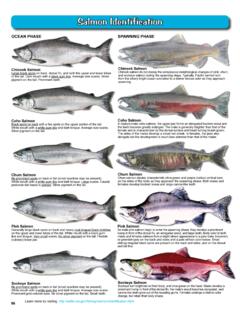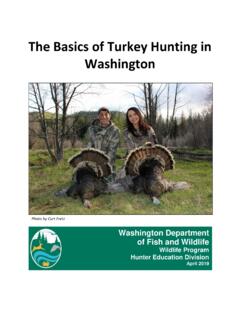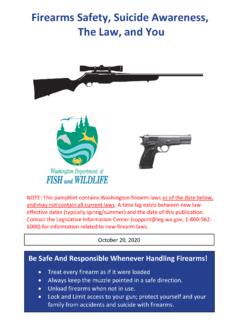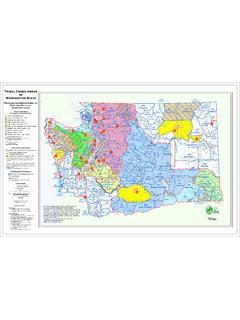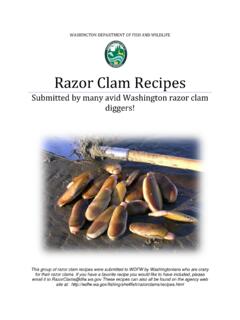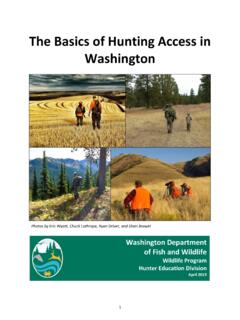Transcription of JEFF BERNATOWICZ , District Wildlife Biologist
1 2019. JEFF BERNATOWICZ , District Wildlife Biologist District 8 HUNTING. PROSPECTS. Yakima and Kittitas counties TABLE OF CONTENTS. District 8 GENERAL OVERVIEW ..1. ELK ..2. COUGAR ..9. WATERFOWL .. 9. DOVE .. 11. FOREST GROUSE .. 12. PHEASANT .. 13. 14. TURKEY .. 16. PARTRIDGE (CHUKAR/HUNGARIAN) .. 18. District 8 GENERAL OVERVIEW. District 8 is located in southcentral Washington. Game management units (GMUs) in District 8. include 328 (Naneum), 329 (Quilomene), 330 (West Bar), 334 (Ellensburg), 335 (Teanaway), 336 (Taneum), 340 (Manastash), 342 (Umtaneum), 346 (Little Naches), 352 (Nile), 356. (Bumping), 360 (Bethel), 364 (Rimrock), 368 (Cowiche), 371 (Alkali) and part of 372.
2 (Rattlesnake Hills). Hunters can choose a variety of habitats, ranging from lowland shrubsteppe and farmland to high elevation alpine wilderness. District 8 is dominated by large blocks of public land and provides abundant hunting opportunities. The District is probably best known for elk. The Yakima elk herd is one of the largest in the state, with over 8,000 animals roaming over 900,000 acres of public land. There are over 4,000 elk in the Colockum herd, which inhabit mostly public land north of Ellensburg. There is also plenty of upland bird hunting opportunity in District 8. Yakima County is near the top for harvest of many bird species, ranking #1 for quail, #2 for dove and chukar, #3 for pheasant, #4 for duck, and #5 for goose.
3 Bird hunters wanting to wander over large areas with low hunter densities have many options in District 8. Along the breaks of the Columbia, the Yakima Training Center consists of 327,000 acres south of I-90, while WDFW manages another 154,000 acres north of the freeway. There are 9,000 acres on the Wild Horse Wind Farm, which utilizes a Hunt by Reservation system. West of the Yakima River, hunters can roam the 105,000- acre Wenas Wildlife Area. A motivated upland bird hunter with a good dog could pursue grouse, chukar, partridge, quail, and pheasant in the same day. Turkeys were introduced over 30 years ago, but populations remained low. In the late 1990s, a more extensive effort was made to augment existing pockets of birds.
4 Post augmentation, the spring harvest increased from 60 in 2001 to 413 in 2010. Harvest has recently hovered around 100 birds. The populations in GMU 335 (Teanaway) have become large enough to allow for a fall permit season. Turkey densities may never reach those found in northeast Washington, but many hunters are finding decent turkey hunting closer to home. District 8 is also home to over 70 percent of the bighorn sheep in Washington. While it is still challenging to draw a permit to hunt sheep, bighorns can certainly add enjoyment to a hunting trip in District 8. Rams are in rut mid-October through November, when many hunters are traveling through the area. There are robust populations of bighorns that can often be easily viewed along Highways 821 (Yakima River Canyon) and 410 (Clemans Mountain, north of the junction with Highway 12).
5 Important Access Changes: Due to low elk populations, early archery antlerless has been reduced to Sept. 14-19 in GMUs 328, 329. 336, 340, 352, 356, and 364. The reduction has understandingly upset some hunters. WDFW strives for harvest equitability among user groups. When elk populations decreased rapidly in recent years due to extreme summer drought 1|P a g e in summer 2015 and a few hard winters, modern firearm and muzzleloader permits were significantly reduced. In 2017, archery hunters (who made up 24 percent of hunters via tag sales). harvested 47 percent of the elk in the District . The shortened season is an attempt to reduce antlerless harvest so populations can rebound.
6 In 2016, two significant changes to hunting access occurred in District 8. The first was that access to the Wild Horse Wind Farm northeast of Ellensburg went to a Hunt by Reservation system. WDFW will be issuing the permits. To watch the video and register, go to There are three time periods for registration. The number of people is unrestricted for the periods before and after the modern firearm elk seasons. For the modern firearm elk season, registration is restricted to 50. hunters per day. Those failing to get one of the 50 spots can drive through the facility, but they can't stop and hunt the wind farm property. The second was access to Yakima Training Center (YTC).
7 A Washington driver's license is still required to drive on the post, but it is no longer a valid form of proof of identity for accessing YTC or any other military facility. An Enhanced Washington State Driver License or a passport are among the valid forms of identification. YTC is expected to have limited access during fall 2019 due to heavy military training activity. For more information on approved form of identification, orientation, and other rules on YTC, call 509-577-3208 or 509-577-3209. ELK. 2|P a g e District 8 used to be the best in the state for elk hunting. However, with that distinction comes relatively high hunter densities. Opening weekend is usually crowded.
8 However, a recent trend has been for hunters to pull up camp and head home before the season ends. If you are looking for a higher quality experience, consider hunting the last two or three days of the modern firearm season or switching to archery or muzzleloader. Archery general season success has recently been almost 10 percent compared to 3 percent for modern firearm and muzzleloader. Early archery antlerless seasons have been shortened, but archers will still likely have double the general season success compared to other weapon users. Surveys this past winter found the Colockum herd declined and was estimated at 4,133 elk. Just a few years ago, the Colockum herd was over 6,000 during March surveys.
9 The Yakima herd was at 8,231elk. Both herds are below management objectives. Modern firearm and muzzleloader elk hunting success in this District strongly correlates to number of spike bulls and permits. With the reduction in permits and low spike-bull numbers (few calves the prior year), 2017 and 2018 harvests were among the lowest in modern history (Figure 1). Calf recruitment has not rebounded, and 2019 general season harvest will likely remain low. Harvest and hunter numbers are shown in Table 1. Figure 2 shows the distribution of collared Yakima elk during September and October, whereas Figure 3 is from a recent study on Colockum elk. Hunters will find more elk at higher elevations and away from roads once seasons begin.
10 The wilderness areas in the Yakima herd range can provide excellent hunting opportunity for those willing to invest the effort to chase elk in the high country. 3|P a g e Figure 1: District 8 Elk Harvest 2500. 2000. 1500. Bull Cow 1000. 500. 0. 2008 2009 2010 2011 2012 2013 2014 2015 2016 2017 2018. Figure 1. District 8 elk harvest. Table 1: Elk General Season Average 2016 -18. GMU antlerless Spike Total Hunters Success 328 178 108 287 3556 8%. 329 43 91 134 1730 8%. 334 12 9 21 381 5%. 335 19 9 28 727 4%. 336 18 15 33 1367 2%. 340 10 46 57 2307 2%. 342 13 24 37 1666 2%. 346 6 45 51 1752 3%. 352 56 23 79 1717 5%. 356 27 26 53 1246 4%. 360 0 40 40 1427 3%. 364 32 17 49 1253 4%.


